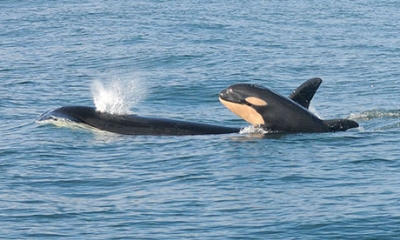
Killer whale

Seeing killer whales off the Oregon coast is a rare treat, but whale watchers can usually count on a pod of orca’s patrolling the coast in mid-April – just in time to intercept baby gray whales. Orcas are most often seen in the ocean off Depoe Bay and Newport, but can be spotted coastwide. The first thing you are likely to see when sighting killer whales is their dorsal fin. Male orcas have a dorsal fin that can be six feet in height, juveniles and females have shorter fins. These large fins can be seen from quite a distance.
There are three distinct types of killer whales: residents, transients and offshores. Each differs in morphology, ecology, behavior and genetics. All three have overlapping ranges so any type could be seen in Oregon waters. In general, resident whales are the most studied. They are found in large pods (groups) and eat primarily fish. Transient whales have been studied in coastal waters and stay in smaller pods generally made up of less than 10 whales and eat primarily marine mammals. Offshores have the largest geographic range and are generally found at least nine miles offshore. They eat primarily fish.
Several times in recent years, orcas came into Yaquina Bay in Newport attracted by the proliferation of seals and sea lions. Some years, they linger at the edges of the bay's jetties. A few years ago, many people watched as a killer whale chased a sea lion all the way through Yaquina Bay, almost as far east as Toledo.
Killer whales usually only stay a couple of weeks, but in 2006, they lingered until the middle of July. The Whale Watch Center receives an average of 30 reports of orca sightings a year. To catch sight of Oregon’s visiting killer whales is just like spotting any whale - you need patience and a high vantage point. The Newport area has many of these, such as the lighthouse at Yaquina Bay, the Yaquina Head area, Don Davis Memorial Park in Nye Beach and nearby at Cape Foulweather. The headquarters for the Whale Watch Spoken Here program is at the seawall in Depoe Bay and is another good place to spot orcas.
Killer whales are an Oregon Conservation Strategy Species in the Nearshore ecoregion.
Photo from NOAA

Find a Rec Report
Current conditions and opportunities to fish, hunt and see wildlife. Updated weekly by fish and wildlife biologists throughout the state.
